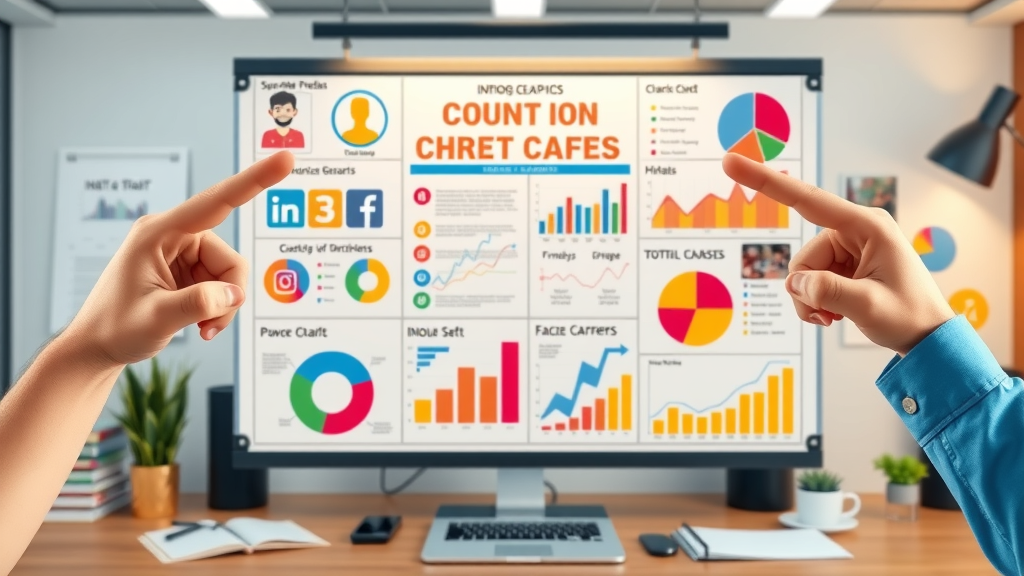- Did you know that 81% of small businesses use social media marketing, yet over half admit they're uncertain about their results? In today's digital landscape, social media marketing for local businesses is more than just a trend—it's a critical component of survival and growth. However, common social media marketing missteps can cost time, money, and potential customers. This guide delivers actionable tactics to help your local business avoid marketing pitfalls and achieve lasting online success.

What You’ll Learn
- How to avoid the most frequent social media mistakes made by local business owners
- Proven strategies for building a compelling social media presence
- How to utilize social platforms and media posts for maximum local impact
- Step-by-step tactics to reach your target audience and measure results
Unlocking Social Media Marketing for Local Businesses: Essential Strategies for Lasting Success
- Real-world examples of successful social media marketing for local businesses
- Critical social media marketing mistakes local business owners make
- Strategic marketing approaches that build a strong social media presence
- How to stand out among small businesses on leading platforms
"Social media is about the people! Not about your business. Provide for the people and the people will provide you."
– Matt Goulart

In the fast-paced digital world, social media marketing for local businesses has become a game-changer for small business owners looking to build their brand and attract new customers. Take a look at establishments like local cafes that showcase behind-the-scenes shots of their staff, or family-owned stores that highlight customer stories on Instagram—these businesses set themselves apart by forming lasting connections online. Still, many local businesses fall into the trap of ad-hoc posting or focusing solely on sales, overlooking powerful ways to engage the community, promote your business, and encourage real conversations. By understanding the essential strategies and classic pitfalls, even the smallest venture can unlock greater visibility and customer loyalty through effective social media marketing.
Building a Solid Social Media Marketing Strategy for Local Businesses
Why a Dedicated Social Media Strategy is a Game-Changer for Local Business
Developing a clear marketing strategy for your social media channels is crucial for any local business aiming to achieve consistent growth. Rather than posting sporadically or copying what national brands do, successful small businesses approach social media as an integral part of their overall marketing plan. A focused social media marketing strategy allows you to define your key goals—whether it’s increasing local foot traffic, boosting online orders, or improving brand recognition. By aligning your media posts, paid social efforts, and engagement tactics with specific outcomes, you’ll avoid wasted efforts and ensure each action contributes meaningfully to your business’s objectives.
For instance, a local boutique may set a goal to expand its customer base among young adults using Instagram stories and geotags, while a neighborhood restaurant might focus on increasing weekday reservations through regular Facebook event posts. A strong strategy includes audience research, competitor analysis, and ongoing measurement, making it easier for business owners to adjust quickly and stay ahead of ever-changing platform trends. The result? A more strategic media presence that supports measurable growth, repeat business, and greater loyalty from your target community.
Aligning Your Marketing Strategy to Your Target Audience on Social Media
Understanding and prioritizing your target audience is the foundation of any successful social media account. Rather than trying to appeal to everyone, narrow your focus to those who are most likely to become loyal customers. Start by analyzing your existing customer base, reviewing followers on your social media platforms, and using platform insights to uncover demographics, interests, and online behaviors unique to your audience. By creating media content tailored to your ideal customer profile—whether it’s parents, college students, or local professionals—you increase the chance of your posts resonating and inspiring real engagement.
Aligning your media marketing message with the needs and preferences of your audience positions your local business as relevant and trustworthy. For example, family-owned bakeries can post stories highlighting fresh morning pastries, while dog grooming salons may connect with pet lovers using fun video clips and pet care tips on their media channels. Every social media post should feel like it speaks directly to your community, reflecting shared values, events, or concerns. This authentic approach leads to higher interaction rates, greater word-of-mouth, and, ultimately, measurable business results.
Top Social Media Platforms for Local Businesses: Where to Invest
In the crowded world of social media platforms, choosing the right ones to invest in can be overwhelming for local business owners. The most effective social media marketing for local businesses starts with understanding where your target audience spends their time. **Facebook** remains a staple for older demographics and local groups, while **Instagram** thrives with visual storytelling and younger crowds. **Google Business Profile** is crucial for search engine visibility, and **TikTok** offers viral potential for creative content and quirky branding. Assessing each platform’s strengths—like Instagram’s geotagging, Facebook’s event tools, or Google’s review integration—lets you pick the best media channels to boost your local media presence.
Remember, it’s not about managing every possible platform, but rather about focusing your energy on two to three media platforms that align closely with your goals and audience habits. Content should be tailored to match the style, preferred format, and best practices of each channel, giving your small business a cohesive yet adaptable strategy. Investing wisely ensures you get a stronger return from your valuable marketing time and dollars.
Comparison of Social Media Platforms for Local Business Marketing
| Platform | Reach | Demographics | Feature Highlights | Ad Cost |
|---|---|---|---|---|
| High (local and broad) | 30+ adults, families | Events, Groups, Messenger, Shops | Low to Moderate | |
| High (visual-focused) | 18-35, young adults | Stories, Reels, Geotags, Shopping | Moderate | |
| Google Business Profile | Local searchers | All ages | Reviews, Local Maps, Bookings | Free/Paid Ads |
| TikTok | Growing, viral | 16-29, trendsetters | Short video, Duets | Low to Moderate |
| Professional, niche | 25-54, professionals | Networking, B2B, Posts | Higher (ads) |

Crafting Irresistible Social Media Posts That Capture Attention
Types of Social Media Posts That Boost Engagement for Small Businesses
- Behind-the-scenes content
- User-generated stories
- Promotions and giveaways
- Community highlights
Elevating your social media presence starts with creating a mix of engaging media posts designed to spark interaction. Behind-the-scenes glimpses humanize your small business, letting customers see the passion and personality behind your products or services. Encouraging followers to share user-generated content—such as reviews, selfies, or tag-a-friend challenges—builds trust and word-of-mouth buzz. Meanwhile, promotions, giveaways, and regular customer spotlights demonstrate appreciation and encourage more active participation from your local audience.
Consistent community highlights, like shouting out loyal customers or collaborating with other local businesses in your neighborhood, can foster a sense of belonging and pride that makes your audience want to return. Each social media post should aim to invite conversation, share valuable information, or inspire action. By experimenting with different post types and formats, you’ll quickly discover what resonates most with your followers and offers the best results for your local business.
Timing and Frequency: Scheduling Social Media Posts for Maximum Exposure
When it comes to successful social media marketing for local businesses , timing can make or break your results. Frequent and well-timed posts increase your media account’s visibility, keeping your business top of mind. For many local businesses, the best times to post are during early mornings, lunchtime, or after work, when your target audience is most likely to browse their feeds. By using scheduling tools or the built-in planner on your social media platform, you can automate media posts and ensure regular updates without having to be online all day.
Posting too infrequently risks losing engagement, while overposting can annoy followers and diminish your brand’s appeal. Most small businesses see the best outcome by posting three to five times per week, adjusting frequency based on analytics and audience interaction. Monitor your data to find your unique “sweet spot”—consistently showing up when your followers are most active is a subtle but powerful marketing tool for staying ahead of the competition.
Consistency and Branding in Social Media Posts for Small Businesses
Consistency in your tone, visuals, and posting schedule is key to building a memorable media presence that local consumers trust. Start by developing a recognizable brand style: consistent color palettes, friendly messaging, and a distinct voice help set you apart from other small businesses in your area. Using branded templates for posts, adding a recognizable logo watermark, and sticking to a theme—whether it’s friendly, quirky, or expert—reinforces your local business’s identity.
It’s not just about how often you post—it’s about nurturing expectations. When customers know they’ll see “Monday Motivation” from your coffee shop or “Friday Foodie” features from your restaurant every week, your content becomes a reliable fixture in their routines. Consistent branding across your social media channels increases trust while minimizing confusion, making it easier for your audience to recognize and recommend your business to friends.
WATCH: Video walkthrough: Creating engaging social media posts that resonate with your local audience

Avoiding the Most Common Social Media Marketing Mistakes Made by Local Businesses
- Neglecting analytics
- Inconsistent posting
- Ignoring customer comments
- Over-promoting products or services
- Misunderstanding platform algorithms
Even the best intentions can lead local business owners to common social media pitfalls. Failing to track analytics means missing out on key insights—without data, you’re guessing which posts work and why. Inconsistent posting can hurt your social media presence by causing you to drop out of your audience’s awareness, while ignoring comments or reviews leaves customers feeling undervalued. Another frequent misstep is focusing too much on self-promotion rather than creating content that adds value or encourages community engagement.
Many small businesses also struggle to keep up with platform algorithm changes, which can affect the reach and effectiveness of their content. Misunderstanding how different social media platforms rank and prioritize posts may lead to underperforming campaigns, wasted ad spend, or stagnant follower growth. By learning from these mistakes and proactively avoiding them, you’ll be better positioned to maintain an active, responsive, and successful media account that drives business growth.
The Impact of Ignoring Data in Your Social Media Marketing Strategy
Analytics are your compass in the world of social media marketing. Overlooking measurements like engagement rates, reach, and click-throughs can result in media posts that miss the mark. Data-driven business owners use available statistics to fine-tune their content, posting times, and promotional efforts, leading to smarter investment and greater ROI. Relying on “gut feeling” alone can cause you to double down on strategies that don’t actually help you reach your target audience.
By leveraging platform insights, even small businesses with limited resources can discover what drives customer action, identify their most loyal fans, and address content fatigue before it affects performance. Regularly reviewing analytics is a proven marketing tool for ensuring your local business media presence stays fresh, relevant, and competitive.
Overcoming Content Fatigue: Keeping Your Social Media Presence Fresh
Content fatigue is a real challenge for media marketing: both the business owner and the audience can grow weary of repetitive, uninspired posts. Refresh your approach by experimenting with new media post formats, such as live videos, behind-the-scenes reels, polls, or collaborations with neighboring businesses. Consistently introducing new types of content keeps your audience engaged and reduces the risk of your social network becoming background noise.
You can also solicit ideas directly from your followers via surveys or interactive Q&A posts, ensuring your content pipeline aligns with what your target audience wants most. Staying flexible and creative is the antidote to burnout, helping your social media presence stand out in a busy digital landscape.
"Content is fire; social media is gasoline." – Jay Baer

Optimizing Media Marketing Strategy for Small & Local Businesses
Leveraging Paid Social Media Advertising for Local Business Growth
Paid social advertising offers a fast-track to increasing your local business’s online visibility and driving targeted traffic. Platforms like Facebook, Instagram, and Google let you craft highly specific ad campaigns aimed at custom audiences based on location, interests, and even purchasing behaviors. By investing a modest budget into paid social campaigns, small businesses can quickly reach thousands of potential customers within their community—much more efficiently than with organic posts alone.
The key is to start small, test various ad creatives, and monitor your results closely. Use clear calls to action, time-limited offers, or event promotions to track which ads deliver genuine business results. As you gain confidence and see what works, consider increasing your budget for greater impact. Paid social is an essential marketing strategy for boosting reach and turning curiosity into real-world sales for local businesses.
How to Build a Cohesive Media Presence Across Social Media Platforms
Building a unified brand across all your media accounts reinforces your reputation and builds trust with potential customers. Begin by developing clear branding guidelines, including a consistent logo, color palette, and messaging style. Use similar profile images and “about” sections across your social media accounts to help users quickly recognize your business, regardless of which platform they visit.
Consistency in tone and visuals doesn’t mean posting identical content everywhere. Instead, tailor your posts to each channel’s unique strengths and audience expectations—for example, share short, fun video clips on TikTok and detailed event promotions on Facebook. An integrated approach to your social media presence ensures you’re memorable and credible, no matter the digital touchpoint.
Measuring ROI: What Local Businesses Should Track in Social Media Marketing
To justify your investment in social media marketing, it’s essential to know which metrics matter most for local business growth. Track engagement rates (likes, shares, comments), website clicks, new followers, and any uptick in inquiries or bookings tied directly to your media posts. For paid social campaigns, focus on cost per click, conversion rates, and return on ad spend.
Advanced tracking might include monitoring coupon code redemptions, event signups, or calls from your social media account profiles. Regular reporting helps you see which marketing strategies bring real value and which should be revised or dropped. An analytical, results-oriented mindset strengthens your media marketing strategy and delivers lasting, measurable business growth.

Developing a Target Audience Analysis for Social Media Success
Identifying Your Ideal Target Audience Using Social Media Insights
Knowing your ideal target audience is the foundation of all great media marketing strategy . Use the analytics dashboards on your social media platforms to break down your follower demographics—age, gender, geography, interests, and active times. Review comments, customer messages, and online interactions to see what truly resonates with your audience. By combining this first-hand research with broader market data, small business owners can design media posts that speak directly to the community’s needs and values.
Creating in-depth audience personas helps you “see” who you’re talking to, so every social media post feels intentional and relevant. This approach ensures your limited marketing resources are spent targeting the local shoppers most likely to become loyal customers, boosting ROI and deepening relationships within your neighborhood.
Tailoring Your Media Posts to the Needs of Your Local Audience
Generic, one-size-fits-all messaging seldom works in local media marketing. Instead, use your audience insights to customize content to your region’s culture, events, and unique preferences. If your research shows most of your community follows food-related hashtags, post regular updates about seasonal menu items or share local recipes. For businesses near a university, highlight student promotions or collaborate with campus influencers to meet your target audience where they are.
The better you adapt your message to local habits and current events, the more likely your followers are to comment, share, and visit your location. Interactive stories, contests with local prizes, and celebrating community milestones are all powerful ways to make your brand feel genuinely connected to the area you serve.
Sample Audience Personas for Social Media Marketing
| Persona | Age | Interests | Local Habits | Platform Preference |
|---|---|---|---|---|
| Emma the Young Foodie | 22 | Trendy cafes, live events | Regularly checks restaurant openings, shares meals on Instagram | Instagram, TikTok |
| Mike the Family Man | 39 | Kids’ activities, special deals | Looks for family-friendly weekend plans, follows Facebook Groups | |
| Sandra the Local Professional | 31 | Networking, after-hours events | Attends local mixers, browses business LinkedIn posts | LinkedIn, Facebook |
| Aaron the Active Student | 19 | School sports, discounts | Searches for flash sales, follows local Snap stories | Instagram, Snapchat |

Building and Managing Social Media Accounts That Stand Out
Create a Professional Social Media Presence for Your Local Business
Professionalism is the foundation of trust in local social media marketing. Make sure each social media account has a high-quality profile photo—preferably your logo or storefront—and a well-written bio that summarizes your business, location, and unique selling proposition. Use pinned posts or profile highlights to showcase important details like your business hours, featured media posts, or ongoing promotions.
A polished profile attracts new visitors and reassures potential customers of your legitimacy. Even if you’re managing your account solo, use a consistent visual theme and take care with spelling and grammar to present your local business in the best possible light.
Essential Tips to Safeguard Your Local Business Media Accounts
Protecting your social media accounts from hacks or unauthorized changes is critical. Use strong, unique passwords and enable two-factor authentication on every media platform you use for your business. Regularly check for suspicious login activity and restrict admin access only to trusted team members. It’s a good idea to back up your business’s digital assets, such as graphics and captions, in a secure cloud location so you can recover quickly in case of a breach.
Additionally, clarify your guidelines for how staff can represent the brand online. Clear standards not only prevent accidental missteps but also sustain a unified voice across all your media platforms, regardless of who’s posting.
Collaborating With Local Influencers to Increase Media Presence
Teaming up with micro-influencers, bloggers, or well-loved community figures can dramatically increase your reach and boost your local business’s credibility. Influencer collaborations can be as simple as inviting them to trial your services or co-hosting an Instagram live event. Local influencers already have established audiences that trust their recommendations, making them a valuable marketing tool for spreading the word about your media posts and new offerings.
Choose partners who align with your business values and target audience to ensure the partnership feels authentic. By cross-promoting across multiple media accounts, both parties benefit, and your social media presence gains local authority quickly.

Maximizing Visibility: Successful Media Marketing Strategies for Small Businesses
Repurposing Content Across Multiple Social Media Platforms
Create once, post everywhere. Repurposing your best content saves time and ensures a consistent message across all your media channels. For example, a Facebook live Q&A can be clipped into Instagram Reels, and a behind-the-scenes photo album can become a TikTok story sequence. Adapt the style and format for each platform, but keep your branding, messaging, and call to action unified.
This strategy multiplies your reach across your chosen media platforms, increases your touchpoints with potential customers, and provides more value from every idea you generate. Be mindful, however, to respect each social media platform’s unique requirements and audience preferences for maximum impact.
Balancing Organic and Paid Social Media Marketing Efforts Effectively
A successful media marketing strategy finds the right mix between organic reach—your regular posts and engagement—and paid social advertising. Organic content is invaluable for building authentic relationships and earning trust, while paid social gives your posts an extra push, especially when launching new products, events, or local deals. Track your overall performance so you know when it’s time to shift more resources into paid campaigns or pull back for broader organic growth.
Smart allocation of budget and resources means you always have the flexibility to respond to changing trends or increased competition, ensuring your small business media presence stays ahead of the curve.
Staying Ahead: Integrating the Latest Trends in Social Media Marketing
- Video-first content
- Ephemeral (disappearing) stories
- AI-driven audience targeting
- Localized hashtags and geotags
Remaining up-to-date with social media marketing trends sets your local business apart as a modern, relevant leader. Video-first content grabs attention and encourages sharing—try live streams, product how-tos, or customer testimonials. Ephemeral posts, like Instagram Stories or Facebook Messenger Stories, feel authentic and urgent, inspiring quick interactions. Use AI-based targeting tools on paid social platforms to finely tune your ad delivery and optimize return on spend.
Employing localized hashtags and geotags boosts your posts in local searches, helping nearby customers discover you easily. Watch what’s trending among your competitors and national chains, then adapt relevant ideas for your unique audience and neighborhood.

How to Encourage Real Community Engagement for Local Business on Social Media
Running Interactive Social Media Campaigns To Build Loyalty
Community engagement is at the heart of successful social media marketing for local businesses. Develop interactive campaigns like photo contests, “caption this” challenges, or encourage customers to share their experiences with your products for a chance to win prizes. These activities not only boost engagement metrics but also foster a sense of belonging and excitement around your brand.
Make it a habit to reply promptly to comments, share user-generated content, and celebrate customer milestones. The more involved your audience feels, the more invested they become in your small business’s ongoing story—both online and offline.
The Power of Online Reviews and Local Recommendations in Social Media Marketing
Customer testimonials and online reviews are invaluable tools for enhancing your media presence . Encourage happy customers to leave feedback on your social media platforms, Google, and relevant local directories. Positive reviews act as personal recommendations, helping undecided shoppers build trust and confidence in your offerings.
Highlight great reviews by sharing them in your stories or regular posts. Authentic, real-world praise is more persuasive than any advertisement—just one glowing review on your media account can spark interest among dozens of potential customers in your neighborhood.

People Also Ask: Industry-Standard Social Media Posting Rules
What is the 5 5 5 rule on social media?
- The 5 5 5 rule for social media involves sharing 5 pieces of content about yourself, 5 pieces from others, and 5 responses to others each week—balancing self-promotion with engagement and value sharing.
What is the 50 30 20 rule for social media?
- The 50 30 20 rule for social media recommends posting 50% original content, 30% curated content from others, and 20% promotional posts to keep your audience engaged and avoid overwhelming them with sales pitches.
What is the 70/20/10 rule for social media?
- The 70/20/10 rule states that 70% of your social media content should build your brand, 20% should share content from other sources, and 10% should be direct promotions.
How to market a small business on social media?
- To market a small business on social media, start by identifying your target audience, select the most relevant social media platforms, create valuable and consistent media posts, engage with users, and analyze your performance for ongoing improvement.
Frequently Asked Questions About Social Media Marketing for Local Businesses
-
What are the best social media platforms for local businesses?
The best platforms are those where your customers spend the most time. Typically, Facebook, Instagram, Google Business Profile, and TikTok offer excellent local visibility and engagement opportunities. -
How often should a small business post on social media?
Aim for 3-5 posts per week on your primary platforms. Monitor analytics and adjust based on what drives the most engagement and fits your audience’s habits. -
Can local businesses benefit from paid social media ads?
Absolutely. Paid social advertising helps local businesses quickly increase visibility, target specific audiences, and track campaign results directly tied to sales or visits. -
What metrics should I track for my social media campaigns?
Focus on engagement (likes, comments, shares), reach, click-throughs, follower growth, and conversions (such as inquiries or sales from social posts). -
How important are online reviews for local businesses on social media?
Online reviews build trust and credibility, influencing potential customers’ decisions far more than traditional ads. Encourage satisfied customers to share their feedback!
Key Insights for Boosting Social Media Marketing Success in Your Local Business
- Choose the right social media platforms aligned with your target audience
- Maintain consistent, valuable, and engaging content
- Monitor analytics to continuously refine marketing strategy
- Balance organic and paid social tactics for optimal reach
- Foster authentic community engagement and encourage customer advocacy
Achieve Powerful Results With Effective Social Media Marketing for Local Businesses
- Start building a standout social media presence for your local business today—implement these field-tested strategies, avoid common mistakes, and turn your social media marketing efforts into measurable growth and visibility in your local community.
 Add Row
Add Row  Add
Add 




Write A Comment